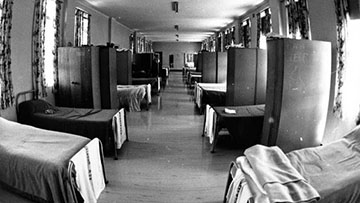Historical asylum notes help recreate play on topic “swept under the carpet”
The following piece was first published online in the Parramatta Advertiser.

Inside Gladesville Psychiatric Hospital circa 1987
WOMEN institutionalised after giving birth is the focus of a unique play being performed in Parramatta.
The topic, often “swept under the carpet”, is the centrepiece of Mockingbird which is an updated version of an Australian-Norwegian-New Zealand co-production.
It was originally developed by Lisa Brickell as a two-person show which traced four generations of women in the one family who all experienced severe mental illness after childbirth.
She has performed it on stage since 2014 but historical records from Gladesville Hospital and Callan Park dating back to the late 1800s added another dimension.
“It’s a topic often hidden away, swept under the carpet and at the most, whispered about behind closed doors,” she said.
“Thankfully things are starting to change ... but there is still a huge amount of stigma around mental illness.”
As the face of the performance, Ms Brickell said some of the stories had been drawn from her own life and her female ancestors.
Coupled with research from Callan Park and Gladesville hospitals, she said the play had become deeper and richer in terms of content and accuracy.
“From my great grandmother’s era when the first character Alice is admitted to the asylum simply for having an illegitimate child and a fever,” she said.
“Through to the dance hall days of my grandmother’s era — who was known as the ‘life and soul of the party’, before having children and being diagnosed with post natal psychosis, to the hippy era of my mother’s generation to modern times.”

Lisa Brickell and Siri Embla star in Mockingbird, a unique play that explores post-natal psychosis.
The play is rich with personal anecdotes, something that was often omitted from a patient’s records.
The Western Sydney University showing of Mockingbird on February 14 will be the first chance for Aussies to see the play. It will be followed by a question and answer with cast and crew.
CASE STUDIES
1954: Shirley, 37, admitted involuntarily to Gladesville Hospital three days after the birth of her sixth child.
Diagnosis: Puerperal psychosis later changed to ‘insanity of pregnancy’.
Symptoms: Six-day history of auditory and visual hallucinations. She could hear people fighting and saw ‘pixies, monkeys and a Chinaman calling out for her help’. She was described as ‘foolish’, ‘irresponsible’, ‘disordered’ and ‘rambling in her conversation’.
Outcome: Her husband consented for Shirley to receive ECT and ICT three days after her admission. She was discharged 14 months later.
Gladesville hospital in 1883. Picture: State Records of NSW
1946: Jessie, 40, was admitted to Gladesville following a two-week history of symptoms.
Diagnosis: Manic depressive psychosis.
Symptoms: She was described as ‘abnormally restless’, ‘insanely violent, emotional, garrulous and so irrational’ that she was incapable of co-operation. She required seclusion and physical restraint. She believed her food was ‘doped’. She had just given birth to her daughter.
Outcome: Her husband signed a consent form for her to start ECT. She was discharged three years later.
1925: A woman, 28, admitted three weeks after giving birth.
Diagnosis: Diagnosed with mania puerperal.
Symptoms: Three-day history of ‘looking depressed and distressed’. Described as ‘emotional, oblivious to questions, restless, resistive and wholly irresponsible ... because she would not stay in bed, requiring restraint’.
Outcome: Two weeks after admission she had a 38.3C temperature and showed signs of having pneumonia in the base of her lungs. Five days later she died from lobar pneumonia and exhaustion.
1888: Mother of five, 27, admitted to Gladesville when her youngest was eight weeks old.
Diagnosis: Very acute mania.
Symptoms: A six-week history of ‘refusing food, being incoherent, preferring the nude’. Described as ‘sleepless’ and ‘laughing and crying simultaneously’.
Outcome: Notes describe her as ‘ladylike’ and she was discharged two weeks later.
THE RESEARCH
Diana Jefferies from Western Sydney University’s School of Nursing and Midwifery led a research team to analyse hospital records of women admitted to Gladesville Hospital and Callan Park Hospital from 1885 to 1955.
Her research found 155 women who were admitted with a diagnosis of mania or psychosis ‘attributed to child-bearing or pregnancy’.
“These records provided insights into the criteria that were used to diagnose women with mental illnesses; the treatment and care that they received in hospital, and the social factors that contributed to their conditions,” Dr Jefferies said.
She said the hospital records provided detailed accounts of the women’s physical and emotional state from a healthcare professional’s perspective but the patient’s voice was missing.
“Very few women were given the opportunity to explain their symptoms or express their feelings about their admission or desire to return home.”
Dr Jefferies said post-natal psychosis was a terrifying experience that increases a mother’s risk of suicide, disrupts the bond between mother and baby and can lead to lifelong psychological problems.
“Unfortunately it is poorly recognised and many women are not diagnosed until the psychosis is severe,” she said.
She said with more awareness and understanding, “that can change”.
THE PLAY DETAILS
WHAT: Mockingbird
WHEN: 7pm, February 14
WHERE: Western Sydney University Parramatta South campus, Rydalmere
TICKETS: via Payments
POST-NATAL PSYCHOSIS
- Post-natal psychosis (postpartam) is a rare mental health condition that affects one or two in every 1000 mothers in the first days or weeks after childbirth.
- It affects about 600 women in Australia every year.
- Symptoms: Finding it hard to sleep; Feeling full of energy or restless and irritable; Feeling strong, powerful and unbeatable; Having strange beliefs; Followed by a combination of manic or depressive symptoms.
January 2018
Mobile options:

